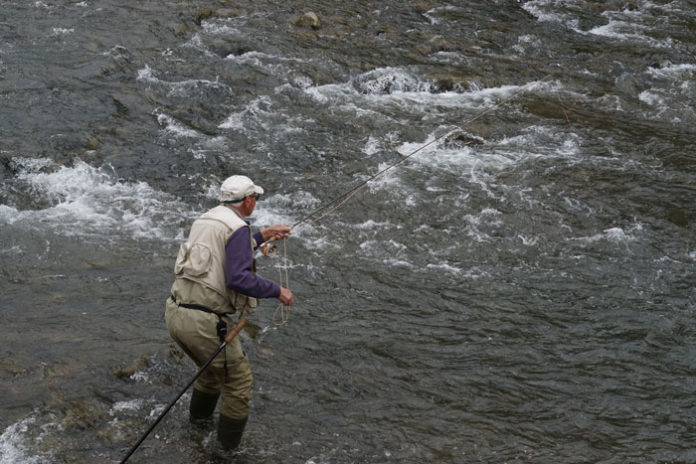Written by: George Daniel, author of Dynamic Nymphing
Joe Humphreys demonstrates his blind-striking technique in a high-confidence lie near his home in central Pennsylvania.
Photo by George Daniel
I enjoy participating in the consumer fly-fishing show circuit every year. Presenting information is fun and I like meeting new people, but I really love sitting in on lectures by other anglers. As I get older, I’m more enthusiastic to listen to seasoned anglers share their knowledge and experiences. Often I learn new tactics, while at other times I’m simply reminded of lessons I may have forgotten. For example, I recently attended the Virginia Fly Fishing & Wine Festival and caught a few minute of Jason Randall’s presentation on “Where to Find Trout.” Jason is a veterinarian by trade, and he brings a simplified scientific approach to his other passion, fly fishing. He recently wrote a fantastic book, Nymph Fishing Masters, a collection of tips and information he obtained while fishing with several knowledgeable nymph anglers across the country.
One of the tips he discussed in his presentation is blind striking while nymph fishing, a tactic in which the angler sets the hook in a likely spot, despite not seeing any strike (e.g. an indicator or sighter hesitating or going under). Instead of watching for confirmation, the angler is simply anticipating a strike. Some anglers may call this a “sixth sense,” but experienced fly fishers who know the water well may refer to this as an educated guess: the laws of probability are too great not to set the hook despite not seeing any reason to set the hook.
Jason mentioned picking up this tip from Joe Humphreys. Incidentally, when I was in my late teens, one of my first lessons while fishing with Joe was about blind-striking. (Then this lesson reemerged 10 years later when another mentor of mine, 1989 World Fly Fishing Champion Wladyslaw “Vladi” Trzebunia, demonstrated this tactic while fishing near the Arctic Circle in Finland.) While watching Joe on my local waters, I noticed him presenting his nymphs to the head of a fast-moving riffle, drifting for two to three seconds, and then immediately lifting to set the hook to begin the next presentation. If there was no fish, his blind strike would unroll behind him, acting as a backcast. However, he would often hook a trout without ever seeing his line or leader hesitate.

In pocket water, trout will often strike a nymphs as soon as they see it.
Photo by Sandy Hays
When I asked him if he saw the fish strike, he was honest and said he did not. He explained that trout holding in pocket water, near shallow banks, and at the top of riffles are often aggressively feeding, which means there’s a tendency for them to jump on a nymph the moment it comes into sight. This quick reaction often translates into a missed strike, as the angler is in the process of adding slack into the presentation to allow the nymphs to drop to stream bottom. Slack is often necessary to give the nymphing rig enough wiggle room to drop to the strike zone.
So Joe would purposely blind-strike during the first and second presentation to a specific area. If he didn’t hook anything on the first two blind-striking presentations, then he would let the third (and all following presentations) drift farther downstream until the nymphs reached the end of the presentation or until he saw a strike. Again, he would blind strike the first 1-2 presentations in a specific lie then let the proceeding drifts occur until the end of the drift or until he noticed a strike. The blind strikes were simply part of his system. This blind-striking approach can be used in all water types, but I’ve found it to be more effective in the water types mentioned above, where trout will jump on your presentation the moment the nymphs enter the water.
Jason Randall refers to these water types as “high confidence lies.” So anytime you’re fishing these high confidence lies, don’t forget to blind strike. It’s an important tactic that even the best anglers I know use. So thanks for the reminder, Jason Randall. I’ll make sure to incorporate blind-striking on my next outing in those high confidence lies, and I hope you do, as well You’ll be surprised how well it works.
George Daniel operates Livin On The Fly, a guide service in State College, Pennsylvania. He is also the author of Strip-Set: Fly-Fishing Techniques, Tactics, & Patterns for Streamers, as well as Dynamic Nymphing.
Credit: Source link































